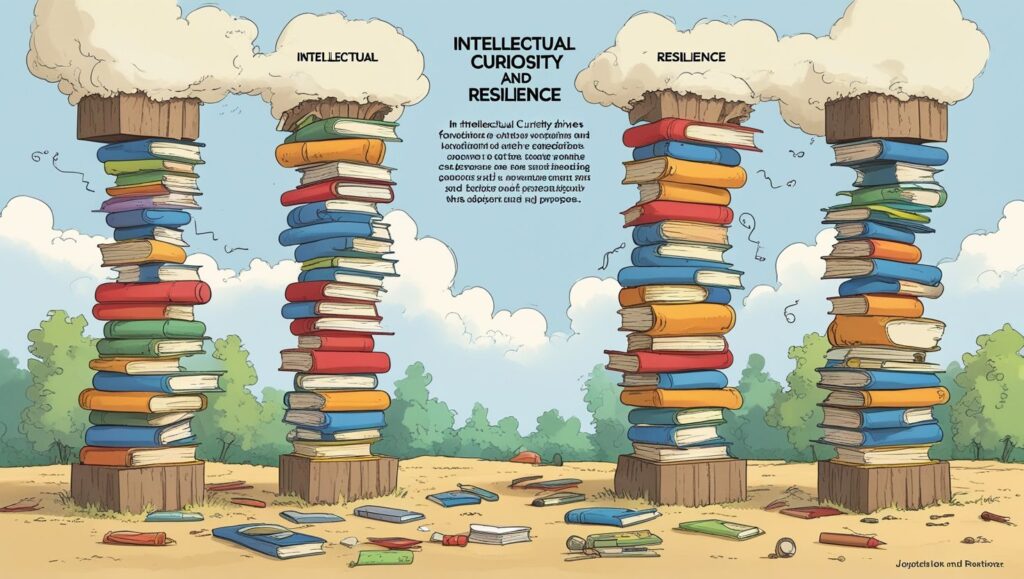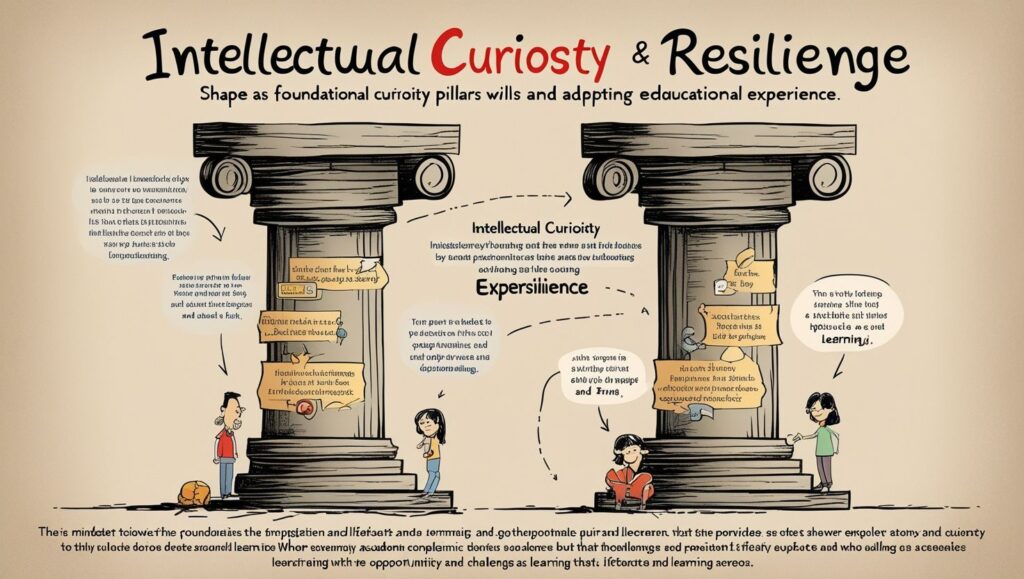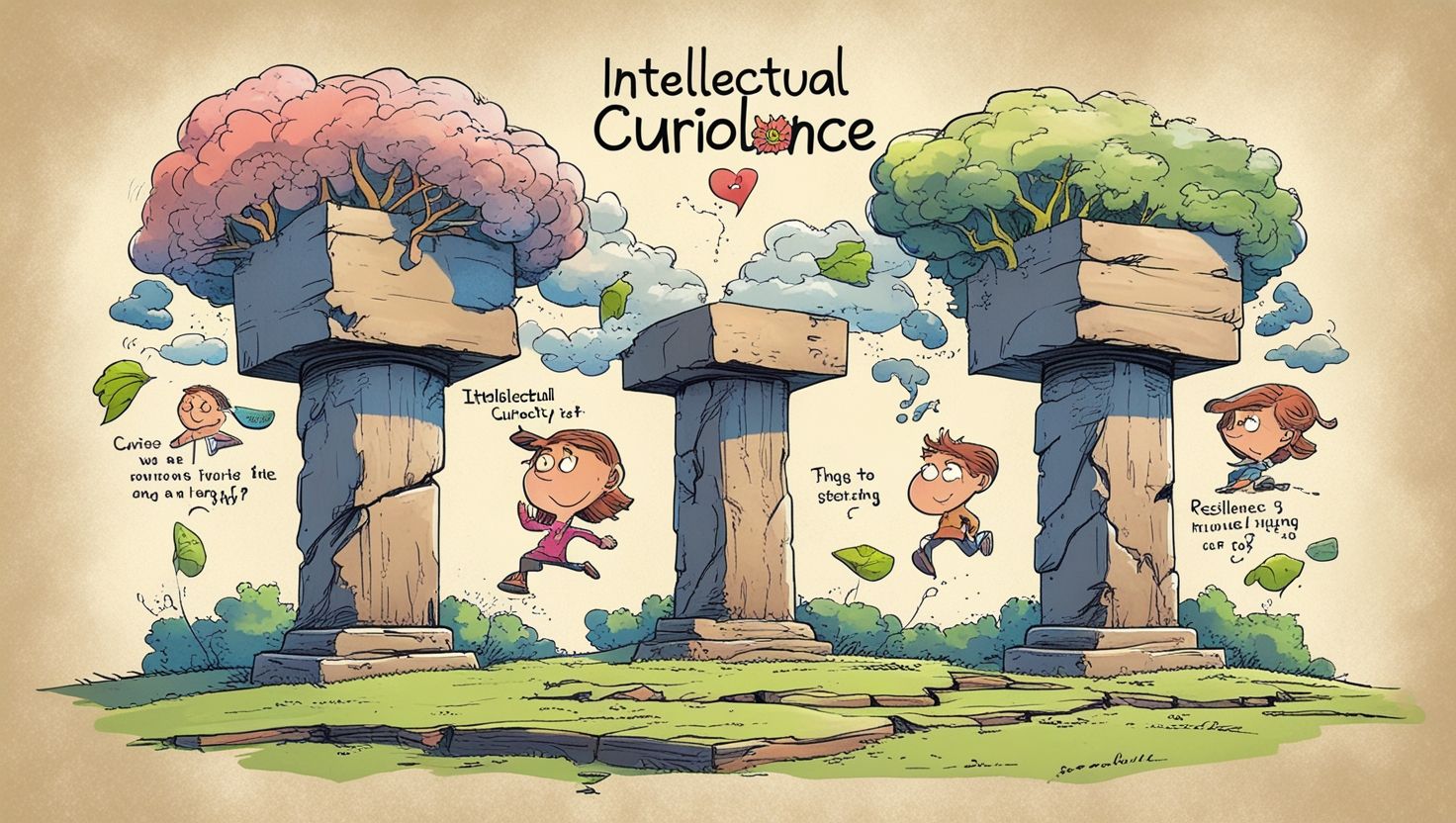Introduction
Intellectual curiosity and resilience serve as foundational pillars that shape a meaningful and enduring educational experience. These interconnected qualities empower individuals to navigate both academic challenges and life’s complexities with adaptability and purpose. Intellectual curiosity drives the pursuit of knowledge, pushing learners to question assumptions, explore unfamiliar concepts, and seek deeper understanding. Resilience, on the other hand, provides the tenacity to overcome setbacks, adapt to difficulties, and persist despite obstacles. Together, they cultivate a mindset that embraces lifelong learning—one where challenges are viewed as opportunities rather than barriers.
The modern world demands more than rote memorization; it requires critical thinkers who can innovate and adapt. Intellectual curiosity fuels this by encouraging exploration beyond prescribed curricula, while resilience ensures that failures become stepping stones rather than stumbling blocks. This dynamic interplay is particularly vital in today’s rapidly evolving landscape, where careers and personal growth depend on continuous skill development and emotional agility.
This essay examines how intellectual curiosity and resilience influence personal development, academic success, and professional readiness. It explores how curiosity sparks discovery, how resilience fortifies perseverance, and how their synergy creates a self-reinforcing cycle of growth. Additionally, it highlights the role of educators in fostering these traits through inquiry-based learning, supportive environments, and strategies that build emotional and cognitive endurance. Ultimately, nurturing these qualities prepares individuals not just for academic achievement but for a fulfilling, adaptable life in an unpredictable world.
Intellectual Curiosity: The Spark of Discovery
At its core, intellectual curiosity is the relentless desire to explore, question, and understand the world. It drives individuals to look beyond surface-level answers, probing deeper into the “why” and “how” of phenomena. This innate trait is evident from childhood, where endless questions and imaginative “what if” scenarios demonstrate a natural thirst for knowledge. However, its true power lies in its ability to evolve into a lifelong passion for learning when nurtured effectively.
In education, curiosity transforms passive absorption of information into active engagement. It encourages students to connect ideas across disciplines, seek real-world applications, and develop independent critical thinking skills. Teachers play a pivotal role by designing lessons that prioritize inquiry over rote memorization—posing open-ended questions, encouraging debate, and linking topics to students’ interests. For example, project-based learning or interdisciplinary studies can ignite curiosity by showing how knowledge intersects in unexpected ways.
Beyond classrooms, curiosity thrives in environments that reward exploration. Access to diverse resources—books, technology, mentorship—allows learners to pursue niche interests, fostering autonomy and creativity. In a world inundated with information, curiosity also equips individuals to discern credible sources, synthesize insights, and innovate. Whether in science, arts, or everyday problem-solving, it is the engine behind breakthroughs and personal growth. By valuing curiosity, education systems can cultivate adaptable thinkers who don’t just consume knowledge but actively shape it.

Resilience: The Steadfast Companion
Resilience is the capacity to endure setbacks, adapt to change, and emerge stronger from adversity. In education, it enables students to navigate academic pressures, from challenging coursework to competitive environments, without losing motivation. Unlike innate talent, resilience is a skill that can be developed through practice, mindset shifts, and supportive structures.
A key component of resilience is the growth mindset—the belief that abilities can improve through effort. Students with this mindset view failures as temporary and instructive, not as reflections of fixed limitations. Educators foster this by praising effort over innate ability and framing challenges as learning opportunities. For instance, constructive feedback that highlights progress (e.g., “Your revision strategies improved this draft”) reinforces perseverance.
Emotional intelligence also underpins resilience. Skills like stress management, self-regulation, and seeking help when needed allow students to cope with setbacks healthily. Schools can teach these through mindfulness exercises, time-management workshops, and peer-support networks. Additionally, resilience is bolstered by community; mentorship programs and collaborative learning environments remind students they’re not alone in their struggles.
In the long term, resilience translates beyond academics. It prepares individuals for workplace challenges, relationship dynamics, and societal changes. By normalizing struggle as part of growth, educators empower students to approach life with confidence and grit.
The Interplay Between Curiosity and Resilience
Curiosity and resilience create a virtuous cycle: curiosity drives exploration, while resilience ensures persistence through the inevitable obstacles of learning. For example, a student researching a complex topic might hit dead ends, but resilience pushes them to seek alternative sources or ask for help, leading to deeper understanding. Conversely, each triumph over difficulty fuels further curiosity, as confidence grows.
This synergy is especially crucial in innovation. Thomas Edison’s 1,000 failed experiments before inventing the light bulb exemplify how curiosity sustains vision, and resilience sustains effort. In classrooms, teachers can model this by celebrating “productive failure”—analyzing mistakes to uncover new questions.
The interplay also fosters adaptability. Curious learners embrace diverse perspectives, while resilient ones adjust when their assumptions are challenged. Together, these traits prepare students for a world where careers pivot rapidly and problems lack clear answers.

Conclusion
Cultivating intellectual curiosity and resilience is not just an educational goal but a life strategy. These traits empower individuals to thrive in uncertainty, turning challenges into growth opportunities. Schools must prioritize inquiry-based teaching, emotional support, and real-world problem-solving to nurture them. The result? Lifelong learners who innovate, adapt, and find joy in the journey of discovery. By embedding these values into education, we prepare future generations not just to succeed, but to lead with creativity and grit.
The Lifelong Impact of Intellectual Curiosity and Resilience
Intellectual curiosity and resilience are not merely academic traits but essential life skills that shape individuals into adaptable, lifelong learners. Together, they form a powerful synergy—curiosity drives the pursuit of knowledge, while resilience ensures perseverance through challenges. This dynamic combination enables individuals to thrive in an ever-changing world, where the ability to learn, unlearn, and relearn is paramount.
In education, fostering these qualities transforms passive students into active seekers of understanding. Curiosity encourages questioning and exploration, pushing learners beyond comfort zones, while resilience equips them to handle setbacks with grit. This mindset shift—from fearing failure to embracing it as part of growth—prepares students for real-world complexities, where problems rarely have straightforward solutions. Beyond academics, these traits are invaluable in careers and personal development. Curious individuals innovate and adapt, while resilient ones navigate uncertainty with confidence. In professions requiring continuous upskilling, such as technology or healthcare, this blend of curiosity and resilience becomes a career accelerator.
Moreover, these qualities enrich personal fulfillment. Curious minds find joy in discovery, whether through travel, reading, or creative pursuits, while resilience helps them overcome life’s inevitable hurdles. Societies that prioritize nurturing these traits—through education systems that reward inquiry and emotional support networks—cultivate citizens who contribute meaningfully to progress.
Ultimately, intellectual curiosity and resilience are the cornerstones of a fulfilling, forward-thinking life. By valuing and cultivating them, we empower individuals to not only face the future with confidence but to shape it with creativity and determination. The true measure of education lies not in the knowledge acquired but in the enduring ability to seek, adapt, and grow—a legacy far beyond any classroom.

q1rqmx
qkqdo8
xdl41j
4zoelb
u9w70s
g89s2o
hxabb2
p0y9h6
Thanks for the auspicious writeup. It if truth be told used to be a enjoyment account it. Look advanced to far brought agreeable from you! By the way, how could we keep in touch?
e2c2zf
otbsrg
v42naq
kmv9un
Wake up your way with this premium CD player alarm clock radio. Whether you prefer to rise with the AM/FM radio, your favorite CD, or a standard buzzer, this versatile alarm clock with CD player has you covered. Its intuitive design includes dual alarms, a large digital display, snooze/sleep timers, and USB charging for your phone. Enjoy high-quality stereo sound from a compact unit that fits easily on any bedside table or shelf. The best clock radios with CD player combine retro functionality with modern convenience—and this one leads the pack.
Rediscover your CD collection with this top-rated clock radio and CD player combo. Ideal for bedrooms, offices, or kitchens, it plays your favorite CDs while also offering a reliable alarm clock radio function. Dual alarms let you set separate wake-up times, and the clear digital display is easy to read day or night. With its stereo radio alarm clock capabilities and optional remote control, this CD alarm clock radio ensures comfort, convenience, and crisp audio in one stylish package. A top choice for those wanting the best CD alarm clock for sound and function.
Your point of view caught my eye and was very interesting. Thanks. I have a question for you. https://www.binance.com/register?ref=P9L9FQKY
Today, while I was at work, my cousin stole my apple ipad and tested to see if it can survive a twenty five foot drop, just so she can be a youtube sensation. My iPad is now destroyed and she has 83 views. I know this is completely off topic but I had to share it with someone!
Fantastic beat ! I wish to apprentice even as you amend your website, how could i subscribe for a blog website? The account helped me a acceptable deal. I were a little bit familiar of this your broadcast provided brilliant transparent concept
In the great design of things you’ll secure a B+ with regard to hard work. Where exactly you confused us ended up being in all the specifics. You know, people say, the devil is in the details… And that could not be more correct in this article. Having said that, allow me reveal to you what exactly did work. Your text is extremely engaging which is most likely the reason why I am taking the effort in order to opine. I do not really make it a regular habit of doing that. Second, whilst I can see a jumps in reason you come up with, I am not certain of how you seem to unite the ideas which make your final result. For right now I will yield to your issue but trust in the near future you actually link the facts better.
I really like your writing style, superb info, regards for putting up :D. “Every moment of one’s existence one is growing into more or retreating into less.” by Norman Mailer.
Hello very cool web site!! Guy .. Excellent .. Superb .. I’ll bookmark your web site and take the feeds alsoKI’m satisfied to search out so many helpful information right here within the submit, we’d like develop more strategies in this regard, thanks for sharing. . . . . .
Your point of view caught my eye and was very interesting. Thanks. I have a question for you.
Your article helped me a lot, is there any more related content? Thanks!
Your article helped me a lot, is there any more related content? Thanks!
Thanks for another informative web site. Where else could I get that kind of info written in such a perfect means? I’ve a undertaking that I am simply now working on, and I have been on the glance out for such information.
Helpful information. Fortunate me I discovered your site accidentally, and I am surprised why this twist of fate did not took place earlier! I bookmarked it.
Way cool, some valid points! I appreciate you making this article available, the rest of the site is also high quality. Have a fun.
I am curious to find out what blog platform you happen to be working with? I’m having some minor security issues with my latest website and I’d like to find something more safeguarded. Do you have any suggestions?
Great wordpress blog here.. It’s hard to find quality writing like yours these days. I really appreciate people like you! take care
I don’t think the title of your article matches the content lol. Just kidding, mainly because I had some doubts after reading the article.
Thank you for your sharing. I am worried that I lack creative ideas. It is your article that makes me full of hope. Thank you. But, I have a question, can you help me?